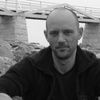Sometimes I wonder if the World's so small
That we can never get away from the sprawl
Living in the sprawl
Dead shopping malls rise like mountains beyond mountains
And there's no end in sight
I need the darkness, someone please cut the lights
-- The Arcade Fire, Sprawl II
When I lived in Charlottesville, the mountain biking trails were 15 minutes away. On a lazy Sunday afternoon, with the sun still high in the sky, I could drive a winding two-lane road through the countryside, past vineyards and horse pastures, to find trails on a hill covered by trees and streams. Now that I live in DC, getting to a park is a whole different story. It means merging into three lanes of traffic and then on to I-95 South, that conduit for long-haul truckers and inter-city drivers, laid out like a ribbon up and down the East Coast.
One of the joys of mountain biking is that over time you become intimate with the trails. You get to know their nuances and rhythms: a root here, a stone there, now a steep dip and a sharp turn, and then the view of the water through the trees. It becomes familiar, and like a trusted lover, it leaves a mark on your soul, deepened over time. Eventually, you get to know its seasons and learn to appreciate the glows of different months: April with pink and tart yellow flowers, August with lush greens, October, full of crispy browns, the leaves crackling like a bowl of Chocolatey Cap'n Crunch.
I like to think of the experience as a connection to place in the same way the French think about "terroir." It involves something personal, and it gets better with age. It can't be just "anywhere." It has to be "somewhere" and that "somewhere" follows its own patterns -- it is its own living organism, with its natural history and cast of inhabitants.
It is precisely this sense of immersion in beauty and history that make the trip home from biking so jarring, as, moving away from the oasis of contained wilderness that is Fountainhead Regional Park, I am catapulted into a no-man's land of four-lane roads, tract housing, and suburban strip-malls.
In his masterpiece, The Poetics of Space, French philosopher Gaston Bachelard writes:
The house shelters daydreaming, the house protects the dreamer, the house allows one to dream in peace... the house is one of the greatest powers of integration for the thoughts, memories and dreams of mankind.
David Gessner expresses similar thoughts. "Why do certain places, certain homes, excite us?" he asks in A Wild, Rank Place, his book about Cape Cod. "The tent or teepee, the tree house or cave. The hidden cottage all our own, sketched in our minds in fuzzy pastels and rich greens."
But many of these neighborhoods, in the Virginia suburbs to the South of DC feel like the opposite of the kind of personal history described by Bachelard. They're more like an appendage of the grid -- a system of transportation and commerce including highways and vast parking lots, with houses strewn about haphazardly as the careless afterthought of a money-making corporate imagination.
Science-fiction tends to think of a hypothetical apocalypse as a great leveling -- an unpredictable force that would clear space, leave a dust bowl, render the landscape unrecognizable. Apocalypse by tract-home and strip-mall construction is slower and less cataclysmic but it too leaves an amorphous landscape -- one with little notion of up or down, left or right: few landmarks and even fewer regional distinctives, a vast expanse of boxy houses and strip malls to numb our imagination and make our soul dull. In its own way, this is an obliteration of history, because the architecture and the surroundings are so non-descript, they cannot possibly be said to be suitable containers for the dreams and aspirations of human beings.
Of course, the remarkable element about human nature is that, like flowers breaking through the concrete of a parking lot, human stories can flourish almost anywhere -- in the midst of civil wars and refugee camps, and even in North-American post-industrial office parks, as Douglas Coupland demonstrated with Generation X: Tales for An Accelerated Culture. But works like Coupland's are pieces of aesthetic resistance. They are a variety of protest literature. They gather their creative burst from reservoirs of imagination stored elsewhere. What will happen when we are enveloped by office parks and soulless homes, to the point where the only artifacts of beauty are found in the museum-like preserves of a few historic city centers?
It's not the development itself that is the problem. It's the manner in which it's done. And as I drive home from mountain-biking through the landscapes of Northern Virginia, I'm reminded that we need to curate the world outside our parks with the same care and attention to beauty that we do inside them. When these elements are well integrated the results can be spectacular. The Buttermilk Trail, on the banks of the James River, in the heart of downtown Richmond is an example of this. The trail itself, carved at half-bank, is stunning. What's around the trail, and the way it has been given shape, is even more remarkable: rail-road track, an urban cemetery with carved tombstones, a suspension bridge, old mansions, quaint and modest houses. The entire experience is an aesthetic masterpiece.
Development and civilization are not the enemy. Without them we would have neither ultra-light mountain-bikes nor well-tended single-track. Thoughtless sprawl is the foe. What we do with our spaces, and how much thought and good taste we put into their build-out, will determine our quality of life for decades to come.
